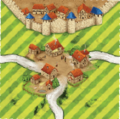Țăranii
Informații generale și comentarii
Lansat inițial în anul 2014 de Hans im Glück.
Țăranii sunt considerați parte a jocului de bază de către majoritatea jucătorilor de Carcassonne. De asemenea, sunt folosiți în fiecare turneu oficial deoarece de obicei nu sunt considerați o extensie. În noua ediție a jocului Carcassonne țăranii au fost separați ca un supliment pentru a face jocul să fie mai ușor pentru jucătorii noi și pentru a simplifica învățarea acestuia. WikiCarpedia urmează acaestă abordare simplificată. În celelalte extensii și în restul WikiCarpedi-ei, țăranii sunt considerați parte a jocului de bază.
What would life be without agriculture? We try to answer part of this question by introducing the hard-working farmers who spend long hours in the fields of Carcassonne. As we did for the roads, cities, and monasteries, the farmers will be presented using the actions of a game turn.
Conținut
- Nimic nou. Doar pisele jocului de bază sunt utilizate.
Reguli
Ataşarea cartonaşului de teren
Mai întâi tragi ca şi până acum un cartonaş, pentru a-l depune pe suprafaţa de joc. Cartonaşul trebuie să se potrivească şi acum cu teritoriile deja existente. Toate suprafeţele verzi din Carcassonne sunt câmpuri.[1]
Plasarea unui meeple în rolul de ţăran
Ţăranul este un meeple pe care îl aşezăm pe câmp în poziţia culcat. „În poziţia culcat?” Da, spre deosebire de tâlhari, cavaleri şi călugări, meepleșii de pe câmpuri trebuie aşezați în poziţia culcat. Această poziţie indică faptul că acest meeple nu se va mai întoarce în rezerva ta pe parcursul jocului şi că doar la sfârşitul partidei vei primi puncte pentru el.[2] Trebuie desigur să ţii cont de faptul că pe teritoriul în care doreşti să-ţi plasezi ţăranul, nu se poate afla alt ţăran. Câmpurile din Carcassonne sunt delimitate de oraşe şi de drumuri. În exemplul alăturat poţi vedea 3 suprafeţe de câmp distincte.
Scoring fields
As mentioned previously, farmers are not scored during the game and, consequently, they do not return to your supply. So place your farmers wisely. Now, let’s assume the game is over and that we are conducting the final scoring. Unlike other features, it is not the field tiles that are counted, but the number of completed cities that border a field. Each completed city that touches a field adds 3 points to the value of that field. All fields touched by a city will see their value increased by 3 points[3][4].

Both the YELLOW and BLACK players have farmers in the same field, but YELLOW has control, so the YELLOW player will be the only one scoring the field's 12 points for completed cities 1 - 4.
The BLACK player in the small field scores 3 points per completed city ( A and B ), for a total of 6 points.
Summary
A brief summary the most important details about farmers:
- Farmers are placed “laying down” on the board.
- Farmers are only scored during the final scoring, not during the game.
- Each completed city adjacent to a field you occupy gives you 3 points.
- Each completed city can be worth points for any number of different fields.
- Similar to roads and cities, if there is more than one farmer in the same field, only the player with the most farmers in that field scores its points. In the case of a tie, each tied player scores full points.
Footnotes
For Icons explanation and licensing please visit Icons page.
- ↑
 Pentru a determina mărimea câmpurilor, câmpurile sunt limitate de orice fel de barieră, de exemplu drumuri, orașe sau râuri care nu pot fi evitate, sau de marginea zonei de joc. Cu siguranță se va întâmpla ca un câmp să acopere aproape întreaga suprafață de joc, și probabil for exista câmpuri care vor rămâne deschise până la sfârșitul jocului.
Pentru a determina mărimea câmpurilor, câmpurile sunt limitate de orice fel de barieră, de exemplu drumuri, orașe sau râuri care nu pot fi evitate, sau de marginea zonei de joc. Cu siguranță se va întâmpla ca un câmp să acopere aproape întreaga suprafață de joc, și probabil for exista câmpuri care vor rămâne deschise până la sfârșitul jocului.
- ↑
 De fapt, unele lucruri din unele extensii (Festivalul, dragonul etc.) permit retragerea țăranilor în timpul jocului. (12/2014)
De fapt, unele lucruri din unele extensii (Festivalul, dragonul etc.) permit retragerea țăranilor în timpul jocului. (12/2014)
- ↑
 Question: It is unclear whether incomplete farms earn points during the final scoring. Answer: It is almost impossible to close off or complete most of the farms. The most important thing when scoring the farms are the cities, which do indeed have to be complete. So: completed cities count on incomplete farms as well.
Question: It is unclear whether incomplete farms earn points during the final scoring. Answer: It is almost impossible to close off or complete most of the farms. The most important thing when scoring the farms are the cities, which do indeed have to be complete. So: completed cities count on incomplete farms as well.
- ↑
 Question: At the end of the game, do we score farms which are completely closed off by roads, but which don't have any adjacent cities? If so, how? Answer: Strictly speaking, they should be scored exactly like every other farm, with 3 points for every completed city. In this case, that makes a total of zero points. And the farmer is nevertheless unable to leave the farm.
Question: At the end of the game, do we score farms which are completely closed off by roads, but which don't have any adjacent cities? If so, how? Answer: Strictly speaking, they should be scored exactly like every other farm, with 3 points for every completed city. In this case, that makes a total of zero points. And the farmer is nevertheless unable to leave the farm.

